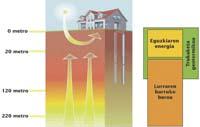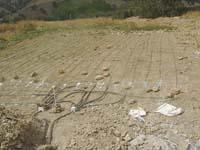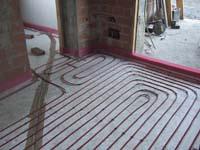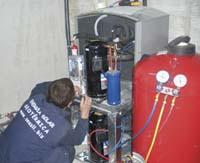In exchange for heat with the earth

Geothermal energy is called energy stored in the soil. When we talk about it, we usually come to mind hot springs, volcanoes and geysers. The accumulation of energy in this type of zones is very high and you can get a lot of them, but they are very few.
Outside these areas of great heat, the floor is at a much lower temperature, but has a feature of great interest: it keeps the temperature throughout the year. This is possible thanks to its density, which as it descends from the surface, in the first hundred meters, increases a degree every thirty meters.
For example, at 15-20 meters deep, the floor is about 17ºC. All year round. It is possible to use a system to take advantage of this energy and air the buildings. In winter, when the outside temperature is lower than that of the subsoil, it can be used to heat houses and other buildings. In summer it can serve to refresh, since the same system also serves to expel the heat that goes accumulating in the buildings and scatter it on the ground.
Underground circuits
To enable the heat exchange with the subsoil, it is necessary to have a piping circuit in the subsoil. Through the tubes runs a fluid that is responsible for performing the heat exchange.
The pipes can penetrate the soil horizontally or vertically, choosing in each case which of them is convenient to place. If the circuit is placed vertically, no large floor surfaces are required to install the system, just having a plot of 14 centimeters in diameter. Yes, it is necessary to make a quite deep hole for the pipes to be introduced (usually over 100 meters).

However, if placed horizontally, the penetration surface of the pipes is much larger (1,5-2 times the surface to be heated by the circuit), but only requires a depth of 1-2 meters.
As always, each one has its advantages and drawbacks. The first is much more expensive than the second because the drilling work is very expensive to install. But it requires a much smaller surface, so it is a perfect solution to use it in areas where there is not much soil.
The circuits can be of various types. Some, for example, use underground water for heat exchange. The underground water is put into circulation, it is passed through the building to air and is returned to the mass of water used.
This and this type of systems are called open systems, since at all times the same water passage is not produced by the pipes. However, the most widespread systems are closed systems. As its own name indicates, always runs the same fluid through the air conditioning circuit. This fluid is sometimes a gas that circulates through the fridges and other mixtures that contain water and an antifreeze product.
As the pipes advance, the fluid exchanges heat with the outer medium of the pipe (it can be the ground itself or a mass of water close to the building).
Base, heat pumps

These circuits could not be launched if they did not have the help of heat pumps. In short, heat pumps are circuits in which a fluid rotates and are able to capture heat from a medium and transmit it to another warmer.
We need a heat pump, for example, if underground water has heated to about 17ºC and we want to keep the area we want to heat to about 20ºC (approximate comfort temperature).
This work is really impossible, since the thermal energy is always transmitted from the hottest point to the coldest. To turn it around, heat pumps "play" with the pressure of the inner fluid. They are based on increasing the pressure of a fluid increases its temperature, and vice versa, by decreasing the pressure decreases the temperature.
When the housing needs to be heated, they adapt the pressure so that the fluid from the tube that comes underground is the hottest and the tube that enters the house is the coldest.
If we want to turn the described and our goal is not only to refresh the house but to heat it, we just need to change the sense of the heat pump. In this way, the heat pump will lead the heat from the housing pipes to the underground pipes. That is why heat pumps are said to be reversible, as they can be used both to heat and to cool any dwelling or building.
Sometimes, the heat pump is composed of a piping circuit that runs underground and that gives heat to the house. The entire system is a large heat pump. In other cases, the heat pump itself is independent, to which a tube is attached from the underground circuit and another from the circuit that heats the house. This heat pump carries heat from one circuit to another.

Heat pumps to modify the pressure of pipes, especially to increase pressure, need to consume energy. However, the benefit obtained with this energy expenditure is very high. In general, it can be said that for every kW they consume, they pass from 3 to 4 kW by the geothermal system.
An old man known in Europe
This system has deep roots in northern Europe and North America, with which they have been working for more than twenty years. Here we start working with this type of systems around the year 2000, and there is still a long way to go. With this aim, the Basque Energy Entity (EVE) organized a day at the BEC of Barakaldo.
The day was attended by experts from some of the countries with the most developed geothermal energy systems in Europe, who explained, among other things, the state of geothermal energy in these countries. For example, in Sweden it was explained if it is in the wind conditions they generate. For example, in Sweden, geothermal exchange allows to obtain between fifteen and one hundred times the wind energy they generate.
Iñigo Arrizabalaga of the EVE also participated as a speaker, who spoke about the situation of geothermal energy in the CAPV. He did it in a very representative way: "We have been installing this type of facility for eight years and any country in northern Europe has been working more than we have done in that period in a morning."
In fact, he pointed out that at the end of 2007, 63 geothermal energy facilities had been built. As a comparison, Arrizabalaga provided data from Sweden and France. In Sweden, at the 2006 census, they had more than 270,000 --Sweden is the most advanced country in geothermal installations. Although France is considered a developing country, in 2006 they had almost 86,000 facilities.

Inadequate infrastructure
Arrizabalaga pointed out several reasons to justify our difference with many countries in northern Europe. First, he noted that these systems work best in schools, office buildings, single-family homes, etc.
In the Nordic countries there are many people who live in this type of houses. In Austria, for example, 83% of the heat pumps they sell are for single-family dwellings.
In the case of ACBC, however, the percentage of single-family households is less than 10%. The vast majority of the population lives in buildings of various homes. The density of the buildings is very high, which makes it difficult for each building to have its own drilling system for geothermal.
In addition, in general, the dwellings are quite old: In 2006, 80% of the 966,000 homes surveyed were before 1991, more than 10% between 1991 and 2001 and the rest since 2001.
The antiquity of the houses entails a series of problems. Among other things, they have lower insulation than more modern homes, so their heating requires more energy, since part of the energy is wasted.

As Arrizabalaga pointed out, the older and less isolated a house, the more energy is needed to heat it. However, the homes that consume less energy in our country consume twice as much as they consume in the Nordic countries, with winters much harder than ours.
The citizens of northern Europe are surprised to know our great consumption. According to Arrizabalaga, the insulation system of households is not the only reason: in our homes instant hot water is generated, while Europeans have hot water accumulation systems. In this way they spend less energy to heat the same amount of water.
Despite the difficulties, this type of air conditioning system is gradually evolving in the ACBC, and more and more institutions and individuals are showing interest for it. In addition, the ways of adapting existing systems are being studied, so that they can be more useful in our market.





